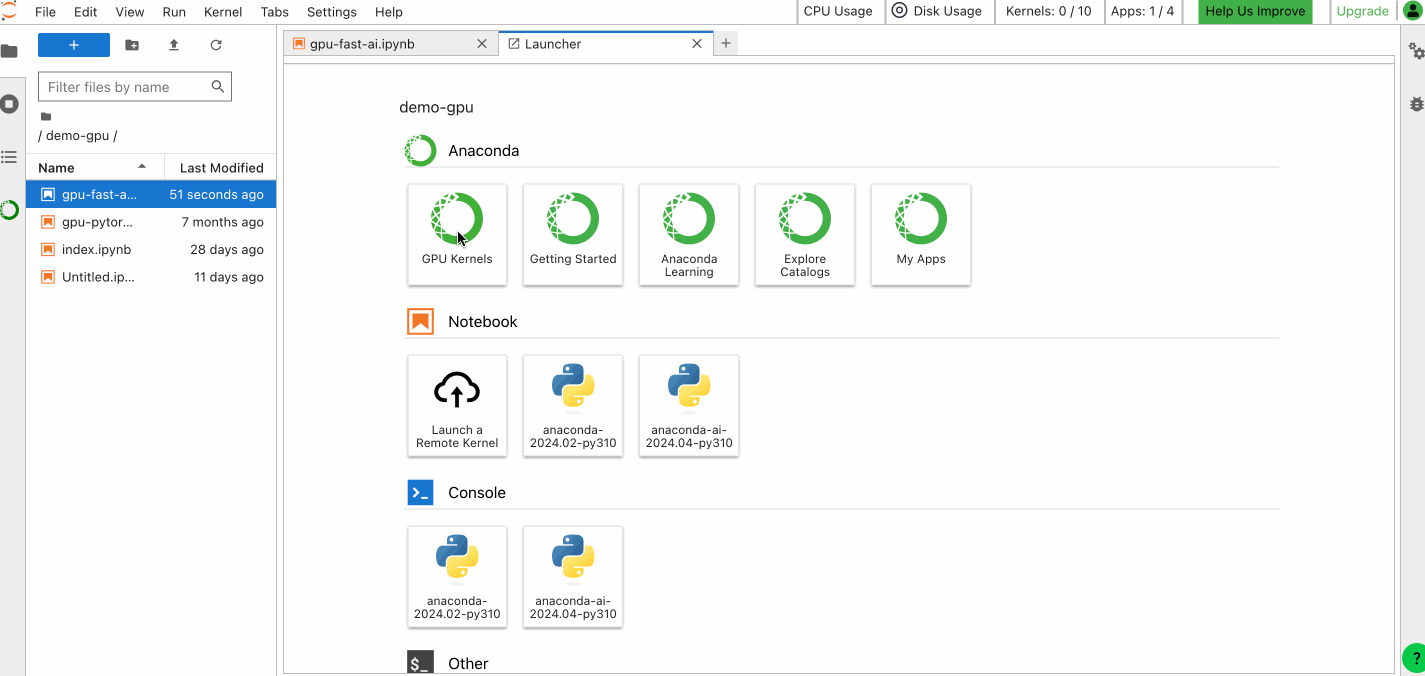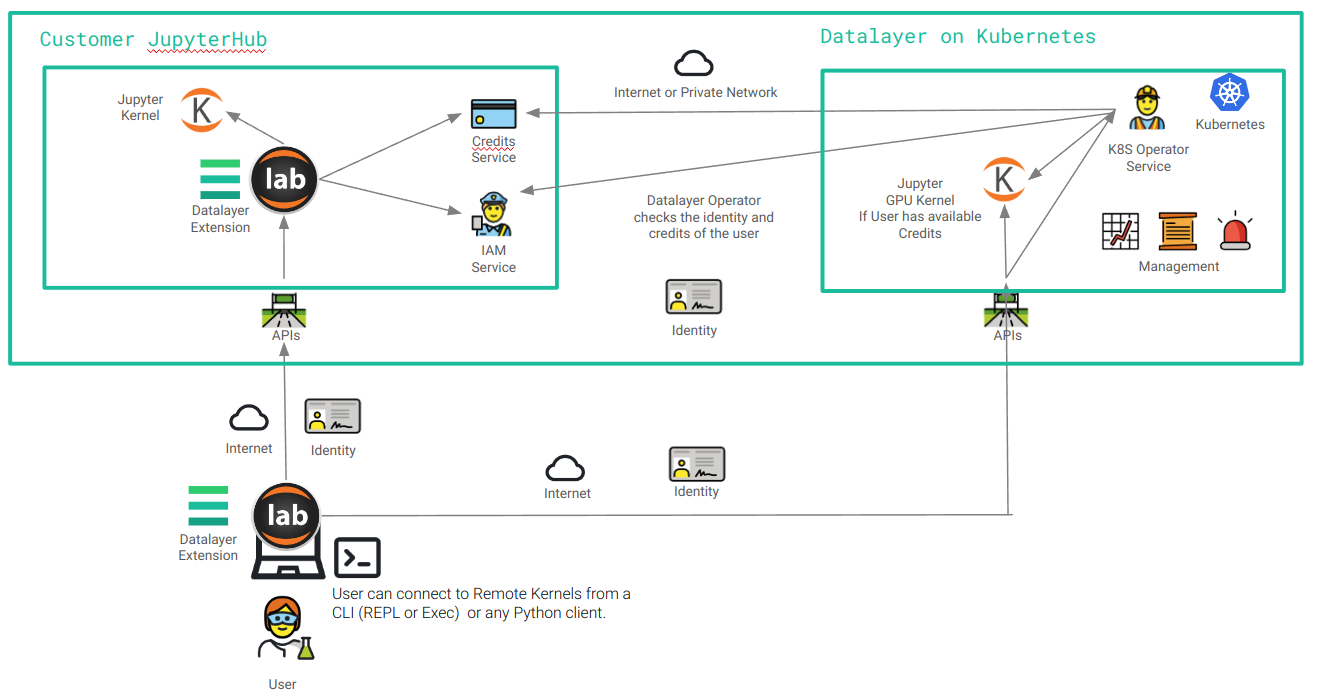Datalayer adding GPU to Anaconda Notebooks
We are thrilled to announce our collaboration with Anaconda, a leader in Data Science and AI platforms. This partnership marks a step forward in our mission to democratize access to high-performance computing resources for Data Scientists and AI Engineers.
Anaconda offers Anaconda Notebooks, a cloud-based service that allows data scientists to use Jupyter Notebooks without the hassle of local environment setup. Through our collaboration, we are enhancing this platform with Datalayer's Remote Runtime technology, bringing seamless GPU access directly to Anaconda Notebooks users.

Why Remote Runtimes and GPUs Matter
In traditional Jupyter Notebook setups, all computations occur locally on a user's machine or a cloud instance. While this setup works well for small to medium-sized tasks, scaling these tasks to handle massive datasets, complex deep learning models, or resource-intensive simulations requires more powerful hardware, such as Graphics Processing Units (GPUs).
GPUs are game-changers for data science and AI because they can parallelize computations, drastically speeding up processes like neural network training, image processing, and large-scale data analytics. However, setting up a local or cloud environment with GPU support can be technically challenging and time-consuming, especially for non-experts.
By upgrading Anaconda Notebooks with Datalayer's Remote Runtime technology, the heavy lifting is done behind the scenes, allowing Anaconda users to focus on what matters most: their data science tasks.
How Datalayer Supercharges Anaconda Notebooks
One of the core advantages of Anaconda Notebooks is its ease of use. Users can quickly launch Jupyter Notebooks with all the libraries and environments they need without the hassle of local configuration. The collaboration with Datalayer builds on this strength, making it incredibly easy for Anaconda Notebooks users to access remote GPU-powered Runtimes.
Users can launch GPU Runtimes directly from the Anaconda Notebooks Jupyter Launcher and switch their Jupyter Notebook to a GPU Runtime with a single click.

Anaconda Notebooks is running on an Anaconda managed JupyterHub while Datalayer Runtimes are running on a separated Kubernetes cluster with IAM (Identity and Access Management) and Credits (Usage) integrations.
Architecture Diagram

Benefits for Anaconda Notebooks Users
The collaboration between Datalayer and Anaconda offers several key benefits to the platform's existing and future user base:
-
Enhanced Performance: Users now have access to powerful GPUs without having to manage the underlying infrastructure. This enhancement translates to faster computations and the ability to handle more complex tasks.
-
Cost-Effective Scaling: By leveraging Remote Runtimes, users only consume GPU resources when needed. They can switch between CPU and GPU Runtimes based on the task, optimizing both performance and cost.
-
User-Friendly: The familiar Anaconda Notebooks interface remains the same, with the added option of GPU Runtimes. No additional learning curve or configuration is required, making it accessible even for non-technical users.
-
Broader Use Cases: With GPU support, Anaconda Notebooks users can now tackle a wider range of projects. From deep learning models and complex simulations to high-dimensional data processing, the possibilities have expanded dramatically.
Datalayer provides one-click access to scalable GPU infrastructure, enabling Data Scientists and AI Engineers at all levels to run even the most advanced AI and ML tasks, integrated with the Jupyter Notebook where they are already working.
For any Business in a Whitelabelled Variant
The Datalayer Runtimes are available for any company in a whitelabelled variant.
Integrating managed deployment of Datalayer with your existing Jupyter solution brings a significant advantage for its operators: it allows quick and straightforward installation of a JupyterLab extension and services on Kubernetes, without requiring additional development. This streamlines operations and enables operators to focus on managing the infrastructure, free from the complexities of configuration.
Reach out for more information on how to integrate Datalayer on you Kubernetes cluster and add Runtimes to your existing Jupyter solution.
Conclusion
Our partnership with Anaconda puts the power of high-performance computing at the fingertips of the Anaconda users, while preserving the simplicity and ease of use that Anaconda Notebooks is known for. This collaboration goes beyond simply boosting computational power; it democratizes access to essential tools, empowering Data Scientists and AI Engineers around the world to achieve more, faster, and with greater efficiency. By breaking down barriers, Anaconda and Datalayer are enabling Data Scientists and AI Engineers to unlock their full potential, paving the way for new innovations.
That Beta availabilty was announced at the latest NVIDIA GTC event. Looking ahead, we plan to refine this solution further by enhancing the user interface and incorporating feedback from early users. Additionally, we aim to integrate the GPU Runtime feature into the Anaconda Toolbox.
To learn how to access this feature, visit the official Anaconda GPU Runtimes documentation as well as this Anaconda blog post.
You can register on the Beta waiting list via this link.

